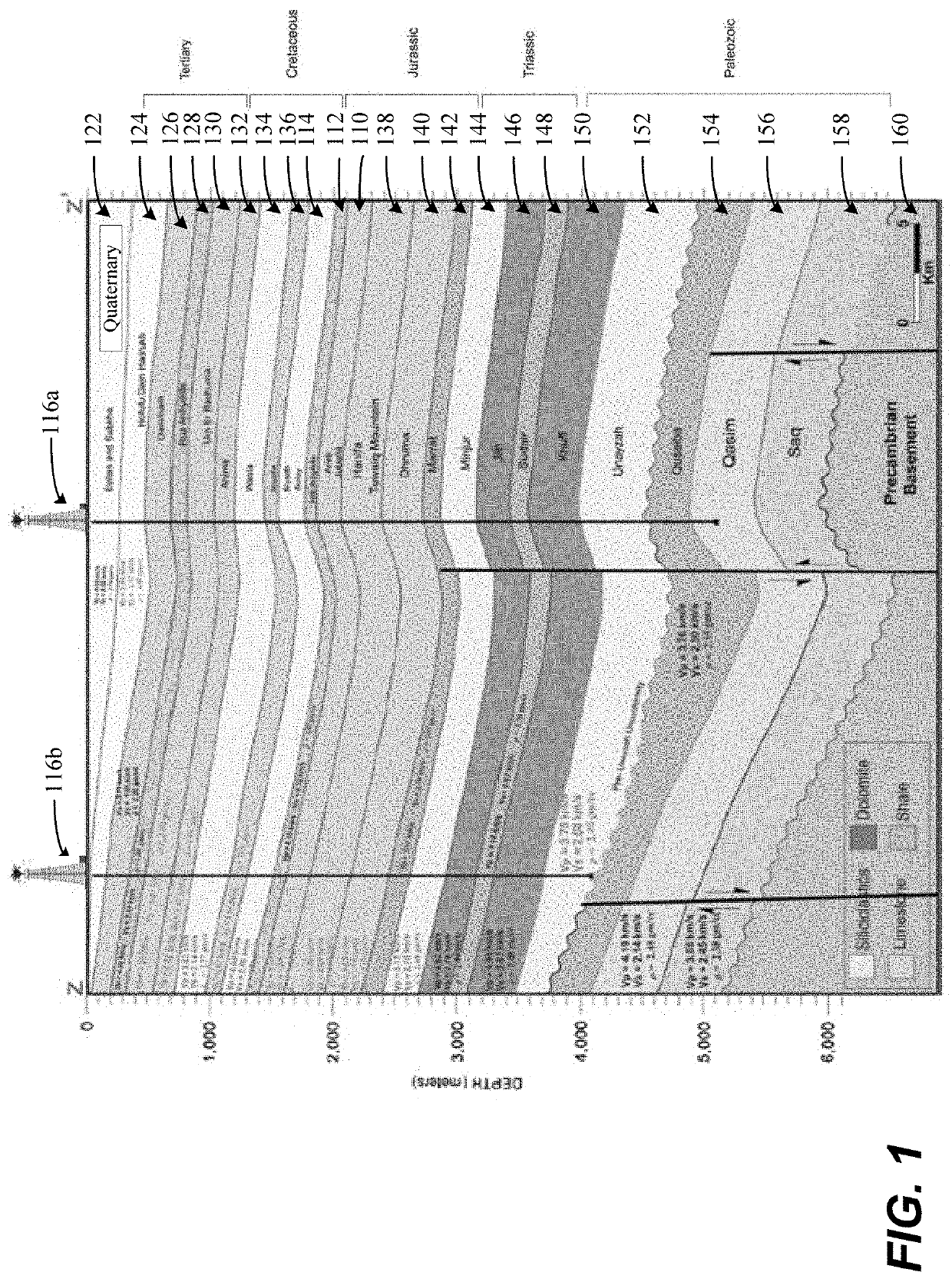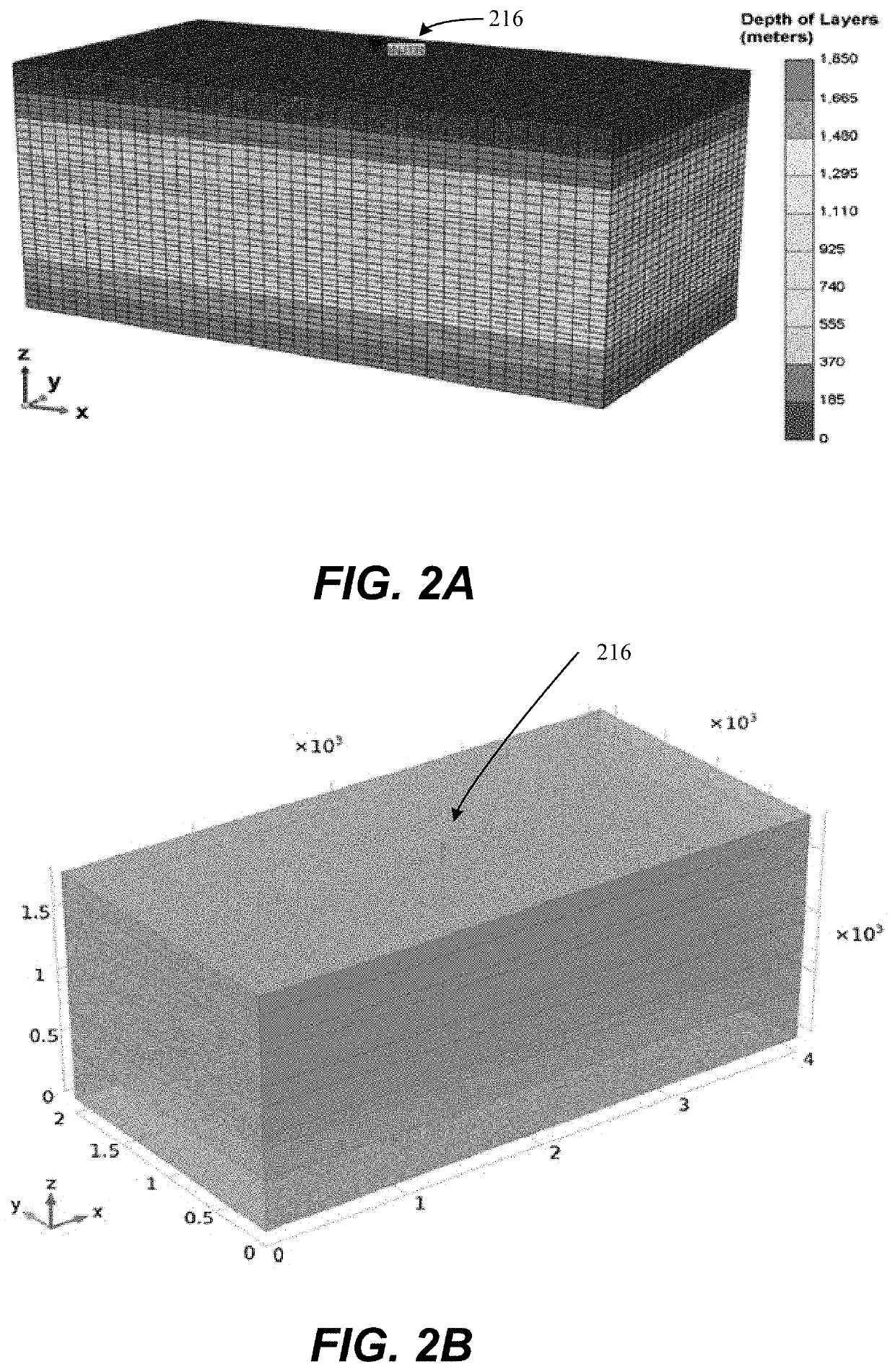Method and alarming system for co2 sequestration
a technology of alarm system and carbon dioxide, applied in the direction of electric/electromagnetic visible signalling, geological measurements, geological models, etc., can solve the problems of significant reduction of reservoir permeability, excessive emission and accumulation of greenhouse gases in the atmosphere, and permeability of porous medium
- Summary
- Abstract
- Description
- Claims
- Application Information
AI Technical Summary
Benefits of technology
Problems solved by technology
Method used
Image
Examples
first embodiment
[0122]The first embodiment is drawn to a method for carbon dioxide sequestration in a geologic reservoir (112 or 114, FIG. 1) having a caprock 122 and a plurality of subsurface layers (124, 126, 128, 130, 132, 134, 136) between the reservoir and the caprock as shown in FIG. 1, comprising constructing a reservoir model (see FIG. 2A, 2B, 18A-18D, 31A-33B), by a computer (5000, FIG. 50) having program instructions (in CPU 5001), a display 5010 and a reservoir database (in memory 5002) stored therein that, when executed by one or more processors, causes the one or more processors to construct the reservoir model which includes reservoir boundary conditions, a three dimensional size of the reservoir, faults in the reservoir, lithography, rock densities, porosities (Ø), and depths of the caprock and the plurality of subsurface layers; initial values of the horizontal stresses (σ), the volumetric strain (εv), the pore pressures, the permeabilities (k0), the pressure wave velocities and the...
second embodiment
[0136]The second embodiment is drawn to an alarming system for leakage in a geologic reservoir (110 or 114, FIG. 1) sequestering carbon dioxide, the geologic reservoir having a caprock 122 and a plurality of subsurface layers (124, 126, 128, 130, 132, 134, 136) between the reservoir and the caprock, comprising a satellite surface imaging database 5003 (see FIG. 50) including topology images of the geologic reservoir taken over a period of time; a memory storing the satellite imaging database, a reservoir database and program instructions; constructing a reservoir model (see FIG. 2A, 2B, 18A-18D, 31A-33B), by a computer (5000, FIG. 50) having program instructions, a display 5010 and a reservoir database (in memory 5002) stored therein that, when executed by one or more processors, causes the one or more processors to construct the reservoir model which includes the reservoir boundary conditions, the three dimensional size of the reservoir, faults in the reservoir, lithography, rock d...
third embodiment
[0140]The third embodiment is drawn to a non-transitory computer readable medium having instructions stored therein that, when executed by one or more processors, cause the one or more processors to perform a method for monitoring the sequestration of carbon dioxide in a geologic reservoir (112 or 114, FIG. 1) having a caprock 122 and a plurality of subsurface layers (124, 126, 128, 130, 132, 134, 136) between the reservoir and the caprock, comprising constructing a reservoir model (see FIG. 2A, 2B, 18A-18D, 31A-33B), by a computer (5000, FIG. 50) having program instructions (in CPU 5001), a display 5010 and a reservoir database (in memory 5002) stored therein that, when executed by one or more processors, causes the one or more processors to construct the reservoir model. The reservoir model includes reservoir boundary conditions, a three dimensional size of the reservoir, faults in the reservoir, lithography, rock densities, porosities (Ø), and depths of the caprock and the plural...
PUM
 Login to View More
Login to View More Abstract
Description
Claims
Application Information
 Login to View More
Login to View More - R&D
- Intellectual Property
- Life Sciences
- Materials
- Tech Scout
- Unparalleled Data Quality
- Higher Quality Content
- 60% Fewer Hallucinations
Browse by: Latest US Patents, China's latest patents, Technical Efficacy Thesaurus, Application Domain, Technology Topic, Popular Technical Reports.
© 2025 PatSnap. All rights reserved.Legal|Privacy policy|Modern Slavery Act Transparency Statement|Sitemap|About US| Contact US: help@patsnap.com



